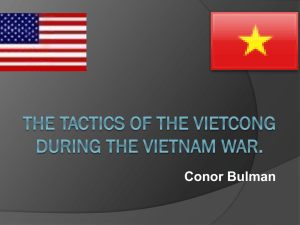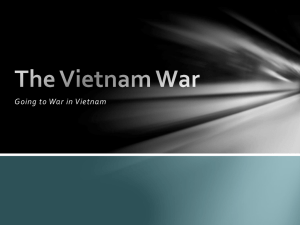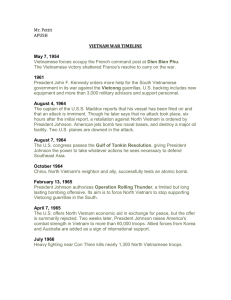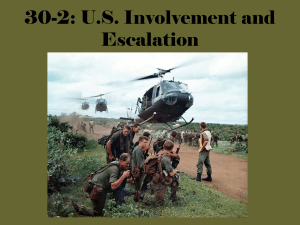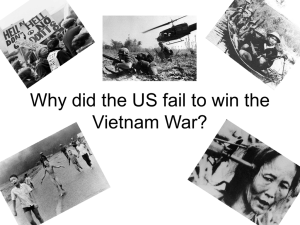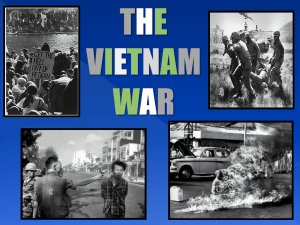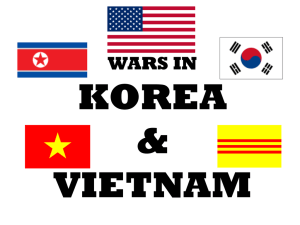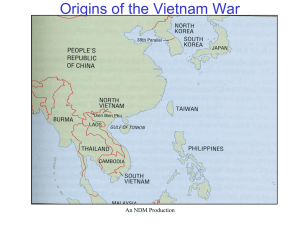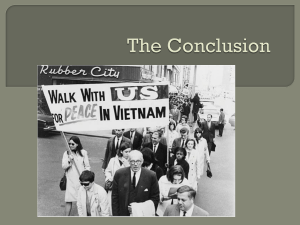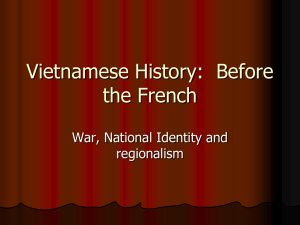Vietnam War Powerpoint
advertisement
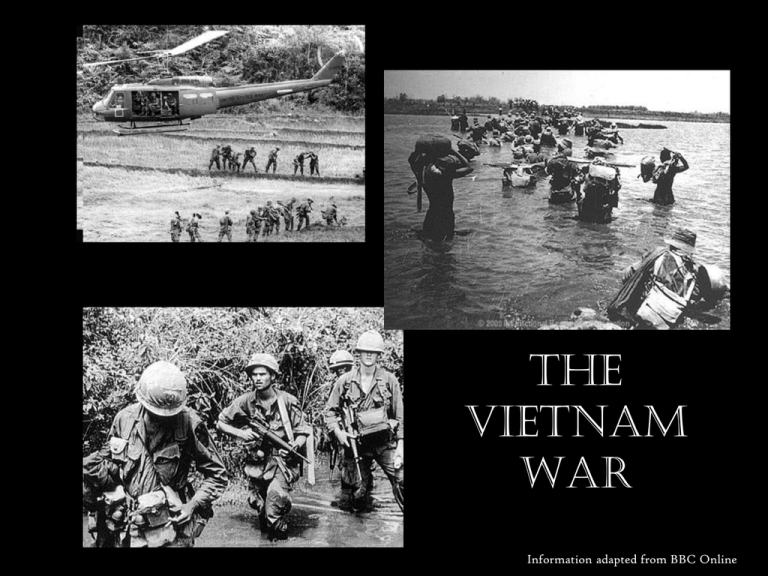
The Vietnam War Information adapted from BBC Online Ho Chi Minh was a communist leader, who was supported by China. In 1960, he set up the National Liberation Front (NLF) in North Vietnam and started a guerrilla (rebel) war in order to take over South Vietnam. The North Vietnamese rebels were called the Vietcong. The Beginning Ngo Dinh Diem, the ruler of South Vietnam during this time received military and financial support from the United States in order to fight the N. Vietcong. The South Vietnamese military was referred to as the ARVN. Gulf of Tonkin In August 1964, sailors on the American warship USS Maddox in the Gulf of Tonkin claimed they had been attacked by North Vietnamese torpedo boats. The US Congress passed the Gulf of Tonkin resolution, allowing the American President Lyndon B. Johnson to take direct military action in retaliation. In February 1965, the Vietcong attacked American air bases and killed American soldiers. President Johnson declared war against North Vietnam. It has been debated whether the attack ever happened. Why did the US get involved? Containment Domino Theory The US was Attacked •China had fallen to communism in 1949, and America had fought in Korea in 1950-53 to contain the spread of communism. •The American government believed that, if South Vietnam fell, Laos, Cambodia and Thailand - and then Burma and India would follow. •The North Vietnamese had attacked the USS Maddox in August 1964, and then killed US soldiers in February 1965. •The US president, Lyndon B. Johnson, said: "I am not going to be the president who saw South-East Asia go the way China went." • They Vietcong fought a guerrilla (rebel) war, ambushing US patrols, setting booby traps and landmines, and planting bombs in towns. They mingled in with the peasants, wearing ordinary clothes. The Americans couldn't identify who the enemy was. • They used elaborate systems of tunnels in order to hide from American spotter planes. • The Vietcong were supplied with rockets and weapons by China and Russia. They used the Ho Chi Minh Trail - a jungle route through Laos and Cambodia - to supply their armies. The Americans couldn't attack their supply routes without escalating the war. • Their tactic was "hanging onto the belts" of the Americans - staying so close to the Americans so they could not use air or artillery backup without killing their own men. Vietcong Tactics American/ARVN Tactics • Americans fought a hi-tech war, using B52 bombers, artillery, helicopters, napalm and Agent Orange an herbicide containing the deadly chemical Dioxin . This killed many innocent civilians, and failed to stop the Vietcong guerrillas. • American troops were sent on patrols, then supported by air and artillery when attacked. This demoralized the soldiers, who realized they were being used just as bait. • Search and destroy patrols went out looking for "Charlie", as they called the Vietcong. But the patrols were very visible by the enemy and easy to ambush. This led to atrocities such as "zippo raids" to burn villages, and the unprovoked massacre of peaceful villagers at My Lai in 1968. Coming to a Close The war slowly came to an end… • Richard Nixon, who became US president in 1969, began Vietnamization - pulling US troops out but giving financial support to the South Vietnamese army (the ARVN). • Nixon ordered large bombing raids on North Vietnam until the North Vietnamese were forced to sign. • Nixon told South Vietnam they had to make peace whether they agreed with it or not, so they were forced to sign too. January 1973: The Paris Peace Agreement was signed, and the Americans left Vietnam. Opposition in America • America was torn apart by this war as many Americans opposed the fighting while others supported it! • The war was opposed particularly by Martin Luther King and by America's black community (because wealthier white men could avoid the draft by going to university or to Canada, and young black men were twice as likely to be killed). • 58,000 Americans (average age 19) were killed. • It was hard for Americans to believe that they were defending America by fighting in a war 8,000 miles away.
![vietnam[1].](http://s2.studylib.net/store/data/005329784_1-42b2e9fc4f7c73463c31fd4de82c4fa3-300x300.png)
